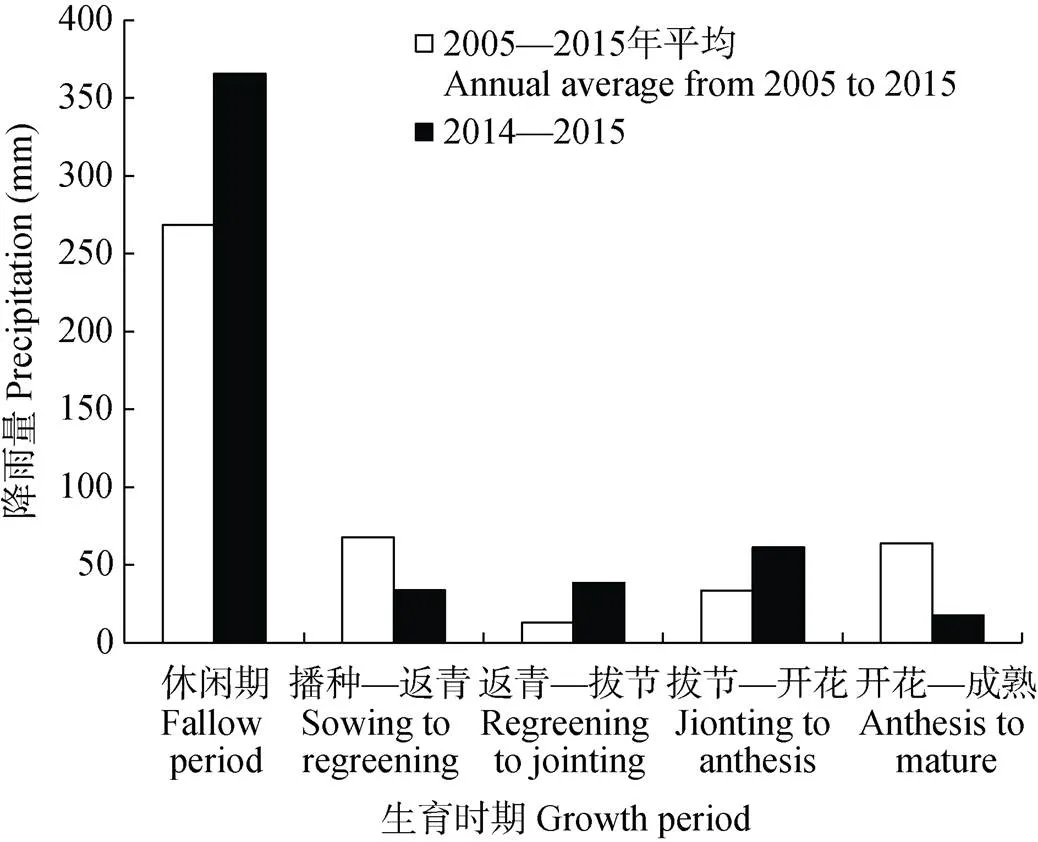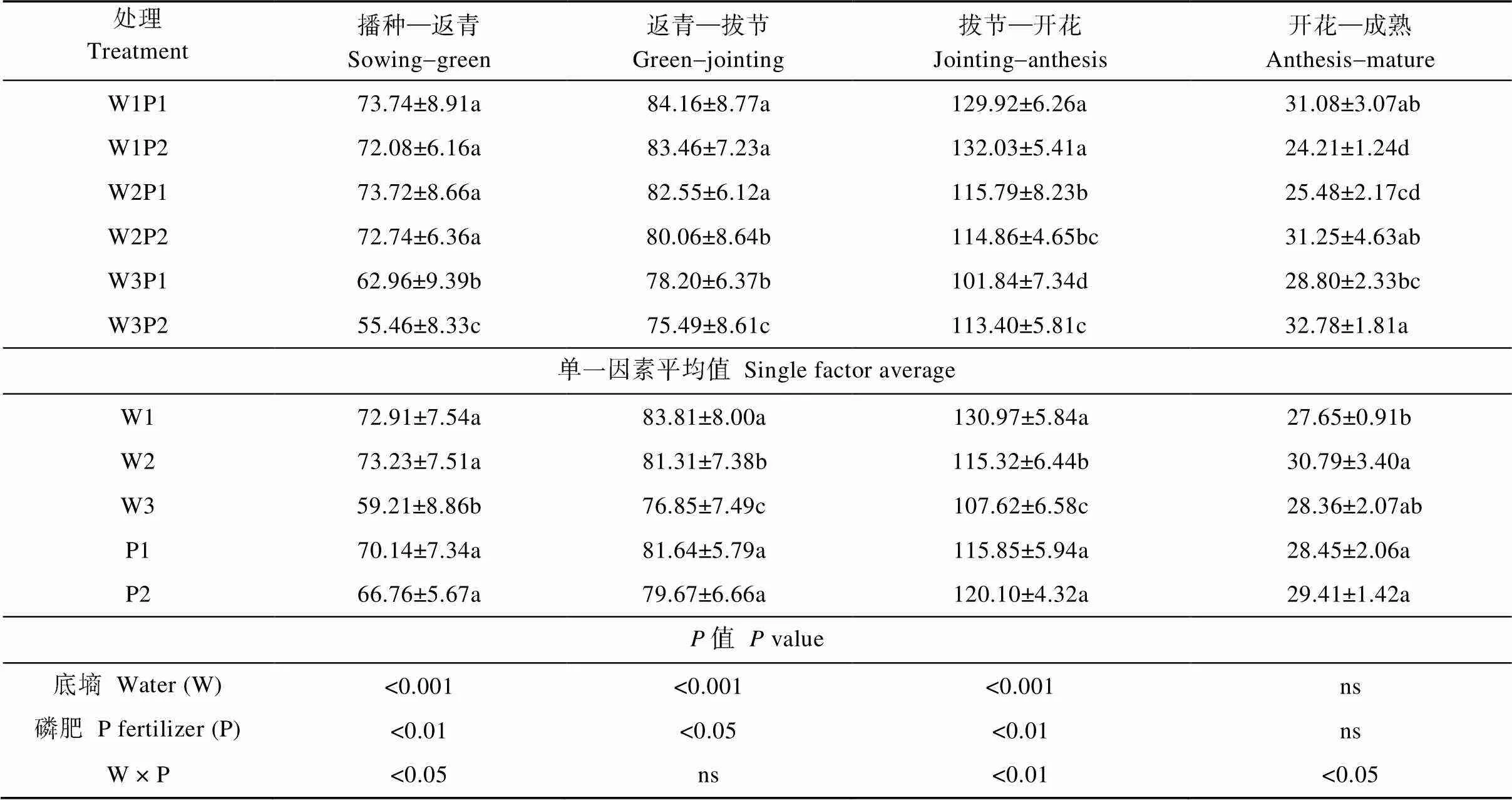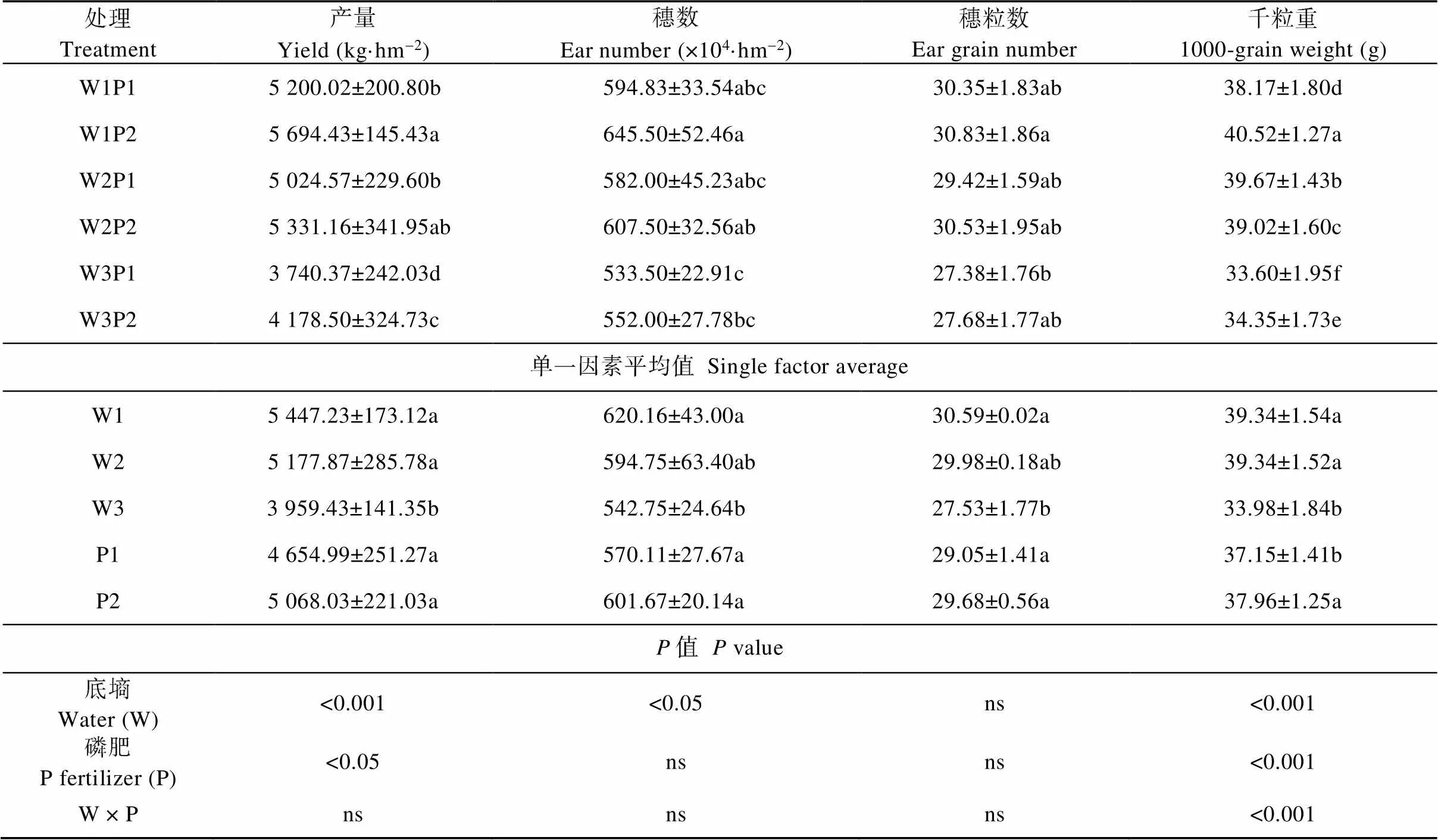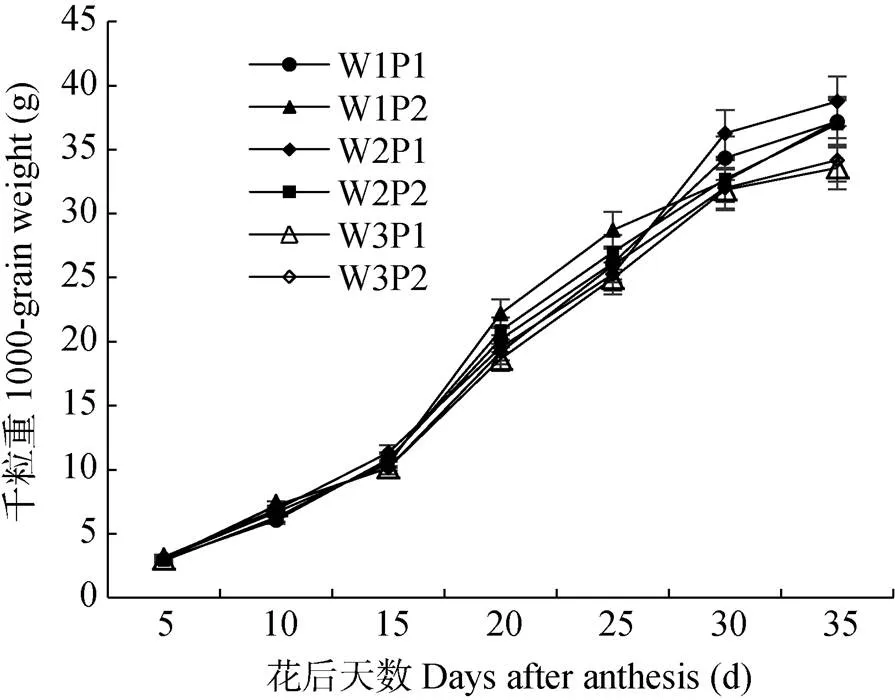底墒和磷肥对旱地小麦籽粒灌浆特性及产量的影响*
原亚琦, 孙 敏, 林 文, 曹碧芸, 田 欣, 高志强**, 李廷亮
底墒和磷肥对旱地小麦籽粒灌浆特性及产量的影响*
原亚琦1, 孙 敏1, 林 文1, 曹碧芸1, 田 欣1, 高志强1**, 李廷亮2
(1. 山西农业大学农学院 太谷 030801; 2. 山西农业大学资源与环境学院 太谷 030801)
为分析黄土高原旱地小麦灌浆过程与水分消耗的关系, 及其产量对底墒和磷肥的响应情况,在山西省南部设3个播前0~100 cm土壤底墒水平W1(248 mm)、W2(233 mm)、W3(205 mm)和两个施磷量P1(75 kg·hm-2)、P2(180 kg·hm-2), 调查不同处理下小麦总耗水、土壤水消耗、各生育阶段耗水、产量及其构成因素、灌浆过程的变化。结果表明, 随着底墒水平提高小麦返青—拔节和拔节—开花阶段耗水、生育期总耗水、土壤水消耗及其占总耗水比例、产量、穗数、千粒重显著增加, 且较W3, W1和W2产量分别显著高14.89%和8.66%。随磷肥增加播种—拔节耗水显著减少, 而拔节—开花耗水、产量、千粒重显著增加。底墒和磷肥互作对小麦总耗水、土壤水消耗、播种—返青阶段耗水、拔节—成熟阶段耗水、千粒重有显著影响。通过小麦灌浆方程得, 快增期持续时间随底墒的增加而增加、渐增期和快增期持续时间随磷肥的增加而增加、缓增期籽粒增加量及持续时间变异系数达25%。通过小麦水(磷)肥方程得, 当0~100 cm底墒为253 mm时获得高产, 且同底墒下产量随磷肥增加而提高。可见, 旱地小麦拔节—开花阶段耗水对底墒和磷肥敏感, 灌浆过程中的快增期持续时间对底墒和磷肥响应较好, 缓增期变异对籽粒粒重影响较大。
旱地小麦; 底墒; 磷肥; 耗水; 灌浆特性; 产量
旱地小麦()在生育期内不进行灌溉, 其生长所需水分由播前底墒和降雨量提供[1-2]。底墒的丰欠在一定程度决定产量[3]。罗俊杰等[4]关于旱塬区底墒和生育期降雨的拟合研究表明, 小麦产量与播前底墒的拟合度高于和生育期降水拟合, 即生育期降雨对产量的效应小于底墒效应, 底墒对产量的方差分析贡献率达38.6%。李超[5]研究表明, 在黄土塬区旱地小麦播前底墒对产量具有决定性作用, 产量随底墒线性增加, 在夏闲期获得足够底墒前提下, 产量可达到充分供水情况下能够取得产量的88%~90%。以肥调水, 以水促肥[6], 水分的研究往往伴随着肥料, 而研究小麦底墒与氮肥的研究较多[6-8], 底墒和磷肥的研究较少。张魏斌等[9]研究表明, 磷肥能提高小麦越冬期—孕穗期0~1 m土层土壤蓄水量, 返青期土壤蓄水量增幅最大; 王昕等[10]研究表明, 干旱条件下, 磷肥能够提高植物的水分利用率和植物的耐旱性。
籽粒干物质的质量主要决定于灌浆过程中的灌浆持续时间和灌浆速率[11], 小麦灌浆过程因品种、栽培措施等不同存在差异[12-14]。通过方程拟合进行分析灌浆过程能够准确得出灌浆持续时间和灌浆速率, 这种方法已经成为研究籽粒灌浆的常规方法[14-16]。而关于小麦灌浆过程研究也已经成熟, 王书吉等[15]研究表明, 同生育期供水正常相比, 亏水处理的灌浆持续时间缩短2.72%~15.78%, 达到最大灌浆速度的时间提前2.33%~14.58%; 赵玉霞等[16]和赵德明等[17]研究表明, 氮硫肥和氮磷肥的配施能提高穗数、延长有效灌浆时间、提高灌浆速率, 增加产量; 陈梦楠等[18]研究表明, 施磷量能提高成熟期穗数, 增加花后0~10 d、15~25 d籽粒灌浆速率, 提高产量。上述小麦灌浆过程研究中, 干旱胁迫采用的是控制灌溉量, 并非是天然的胁迫条件, 对于旱地小麦生产的实际意义较小; 肥料试验仅是种类, 没有涉及水肥耦合。所以, 在天然干旱胁迫条件下, 小麦灌浆过程, 水肥耦合研究鲜见报道。由此, 本研究以不同播前底墒条件下, 设置两个施磷量, 以小麦阶段耗水量为媒介, 探究籽粒灌浆过程对底墒和磷肥的响应情况, 找出山西省南部旱地小麦播前底墒的合适施磷量, 既保证小麦灌浆过程, 又降低土地的肥料成本投入, 为旱地小麦稳产高效提供一定的理论依据。
1 材料与方法
1.1 试验地概况
试验在山西省闻喜试验基地进行, 地属温带大陆季风气候区, 年日照2 179 h, 平均气温13.7 ℃, 霜冻期为10月下旬至翌年4月上旬, 无霜期207 d。试验地是一年1熟旱作农区, 7—9月为休闲期, 且其土壤类型为褐土, 2014年10月1日用土钻取播前0~20 cm土壤样品、风干, 并于2014年10月4日在山西农业大学农学院作物栽培重点实验进行测定。其肥力为: 有机质10.55 g·kg-1、碱解氮37.65 mg·kg-1、速效磷17.64 mg·kg-1。小麦休闲期、各生育期降雨量见图1。

图1 闻喜县试验点小麦休闲期及不同生育时期降雨量
1.2 试验设计
供试小麦品种为‘运旱20410’, 采用二因素裂区设计, 主区为播前1 m蓄水量(底墒), 设3个处理: W1(248.81 mm)、W2(233.19 mm)、W3(205.72 mm)。底墒通过休闲期土壤表面渗水地膜面积占小区土壤面积的比例进行控制, 即土壤水蒸发量差异形成不同的底墒。2014年7月15日进行渗水地膜全覆盖(渗水地膜覆盖小区100%的面积, W1)、半覆盖(渗水地膜覆盖小区50%的面积, W2)和不覆盖(W3), 形成不同底墒处理, 2014年8月25日回收地膜并平整地块。副区为两个施磷量: P1(75 kg·hm-2)、P2(180 kg·hm-2), 施用磷肥为过磷酸钙, 折算成P2O5, 2014年10月1日播种时施入。播种时所有处理基施180 kg∙hm-2N和150 kg·hm-2K2O(氮、钾肥分别为尿素和氯化钾), 机械条播, 行距20 cm, 小区面积为150 m2(50 m×3 m), 重复3次, 2015年6月10日收获[19]。
1.3 测定项目及计算方法
1.3.1 土壤水分的测定
用土钻分别于播种期(2014年10月1日)、返青期(2015年3月15日)、拔节期(2015年4月3日)、开花期(2015年4月28日)、成熟期(2015年6月10日)采集1 m深土壤样品, 每个小区取3个点。其中每20 cm为1个土层, 样品采集后立即装入铝盒, 采用烘干法测定土壤质量含水量, 土壤剖面环刀法测定其容重(2014年9月30日)[19]。土壤蓄水量公式:
SW0.1´´´(1)
式中: SW为蓄水量(mm),为土壤质量含水量(%),为土壤容重(g·cm-3),为土壤厚度(cm)。
1.3.2 籽粒干物质测定
花后每隔5 d取样一次, 每个小区取20穗, 当天分离籽粒, (105±5) ℃杀青30 min, 80 ℃烘至恒重[15]。取样时间分别是2015年5月3日、2015年5月8日、2015年5月13日、2015年5月18日、2015年5月23日、2015年5月28日、2015年6月2日。
1.3.3 成熟期考种及产量测定
成熟期(2015年6月10日)调查单位面积穗数、每穗平均粒数及千粒质量, 每个小区取50株测定生物产量; 收割20 m2, 计算经济产量。
1.3.4 灌浆拟合及特征参数的计算
灌浆拟合选择Logistic曲线:
/(1ea-rt) (2)
式中:为最大生长量上限, a、r为常数, e为自然对数底,为时间[15]。参考殷祚云[20]的四点法求得值, 最小二乘法求得值。参考王书吉等[15]将Logistic方程求一阶导数得到最大灌浆速率(max)及其出现时间(max), 求二阶导数得到渐增期(1)、快增期(2)、缓增期(3)持续时间, 通过反演得到对应阶段的籽粒增加质量1、2、3, 以及对于阶段的平均灌浆速率1、2和3。
1.3.5 粒重的水(磷)肥效应拟合
多项式回归的优点是更逼近变量的实际值, 缺点是可能存在与因变量无关的自变量组合(项式)[21-22]。故首先计算自变量的多项式, 再使用逐步回归剔除掉与因变量无关的自变量组合(项式)。本文以籽粒产量()为因变量, 底墒(1)和磷肥(2)为自变量, 分别计算自变量的二次多项式组合:12、22、12、1、2, 使用SPSS 22.0中逐步回归分析剔除与产量相关程度低的自变量组合, 进而得到与产量相关程度大的粒重水(磷)肥效应方程。
1.4 数据分析
采用Micsoft Execl 2013录入数据和作图, 统计分析和作图分别采用SPSS 22.0和Maple 2018处理数据。
2 结果与分析
2.1 不同底墒配施磷肥对小麦耗水的影响
2.1.1 小麦总耗水、土壤水和降雨量的耗水量及其比例
随着底墒的增加, 小麦总耗水、土壤耗水量及其占总耗水比例逐渐增加, 降雨量占总耗水比例逐渐降低(表1)。W1底墒下, 随磷肥的增加小麦总耗水、土壤耗水量及其占总耗水比例随之降低, 降雨量占总耗水比例相反; W2、W3底墒下, 随磷肥的增加小麦总耗水、土壤耗水量及其占总耗水比例随之增加, 降雨量占总耗水比例相反。较W3, W1和W2小麦总耗水、土壤耗水量及其占总耗水比例分别高14.89%和8.66%、33.13%和19.26%、15.87%和9.77%。经显著性检验得, 底墒、底墒与磷肥互作分别对总耗水、土壤耗水量影响均达到显著水平, 底墒分别对土壤耗水量、降雨量的占总耗水比例影响达到显著水平。

表1 底墒和磷肥对小麦总耗水、土壤水和降水量的耗水量及其比例的影响
W1、W2和W3分别表示播前底墒为248.81 mm、233.19 mm和205.72 mm; P1和P2分别表示施磷量75 kg(P2O5)·hm-2和180 kg(P2O5)·hm-2。不同小写字母表示<0.05水平差异显著, ns表示影响不显著。W1, W2 and W3 represent soil moisture before sowing of 248.81 mm, 233.19 mm and 205.72 mm, respectively. P1 and P2 indicate phosphorus application of 75 kg(P2O5)·hm-2and 180 kg(P2O5)·hm-2, respectively. Different lowercase letters indicate significant differences at< 0.05. “ns” means no significant effect.
2.1.2 小麦阶段耗水量
随着底墒的增加, 播种—返青、开花—成熟的阶段耗水量先上升后下降, 返青—拔节、拔节—开花的阶段耗水量逐渐上升(表2)。相同底墒下, 播种—返青、返青—拔节阶段耗水量随着磷肥的增加而降低, 拔节—开花阶段耗水量则相反。较W3, W1和W2小麦返青—拔节、拔节—开花的阶段耗水量分别高9.06%和5.80%、21.70%和7.16%; 较P1, P2小麦播种—返青、返青—拔节阶段耗水量分别降低约4.82%、2.41%, P2拔节—开花阶段耗水量升高约3.67%。经显著性检验得, 底墒、磷肥、底墒与磷肥互作分别对播种—返青、返青—拔节、拔节—开花、开花—成熟的阶段耗水量影响均达到显著水平, 底墒与磷肥互作对返青—拔节阶段耗水量影响不显著。
2.2 不同底墒配施磷肥对小麦产量及其构成因素的影响
2.2.1 对产量及其构成因素的影响
随着底墒的增加, 小麦产量及其构成因素(穗数、穗粒数、千粒重)逐渐上升(表3)。相同底墒下, 小麦产量、穗数、穗粒数随着磷肥的增加而增加。较W3, W1和W2小麦产量、穗数、穗粒数、千粒重分别高37.58%和30.77%、14.26%和9.58%、11.10%和8.87%、15.81%和15.81%; 较P1, P2小麦千粒重高约2.18%。经显著性检验得, 底墒、磷肥分别对小麦产量、穗数、千粒重影响均达到显著水平(磷肥对穗数影响不显著)、底墒与磷肥互作对小麦千粒重影响达到显著水平。

表2 底墒和磷肥对小麦不同生育阶段耗水量的影响
W1、W2和W3分别表示播前底墒为248.81 mm、233.19 mm和205.72 mm; P1和P2分别表示施磷量75 kg(P2O5)·hm-2和180 kg(P2O5)·hm-2。不同小写字母表示<0.05水平差异显著, ns表示影响不显著。W1, W2 and W3 represent soil moisture before sowing of 248.81 mm, 233.19 mm and 205.72 mm, respectively. P1 and P2 indicate phosphorus application of 75 kg(P2O5)·hm-2and 180 kg(P2O5)·hm-2, respectively. Different lowercase letters indicate significant differences at< 0.05. “ns” means no significant effect.

表3 底墒和磷肥对小麦产量及其构成因素的影响
W1、W2和W3分别表示播前底墒为248.81 mm、233.19 mm和205.72 mm; P1和P2分别表示施磷量75 kg(P2O5)·hm-2和180 kg(P2O5)·hm-2。不同小写字母表示<0.05水平差异显著, ns表示影响不显著。W1, W2 and W3 represent soil moisture before sowing of 248.81 mm, 233.19 mm and 205.72 mm, respectively. P1 and P2 indicate phosphorus application of 75 kg(P2O5)·hm-2and 180 kg(P2O5)·hm-2, respectively. Different lowercase letters indicate significant differences at< 0.05. “ns” means no significant effect.
2.2.2 产量与其构成因素间的关系
将产量与其三要素进行线性拟合, 得出的方程为=5.391+214.992+77.193-7 507.39(、1、2、3分别是产量、穗数、穗粒数、千粒重), 决定系数2达0.990 8(表4)。分析通径系数看出, 对产量直接影响最大的穗粒数, 系数达0.43; 间接影响在系数上1→2>1→3,2→1和2→3系数上相近(在0.27左右),3→2>3→1; 直接+间接的综合影响则是穗数、穗粒数和千粒重的贡献相近。可见, 产量三要素对产量的贡献相近。

表4 小麦产量及其构成因素的拟合方程及通径系数
、1、2、3分别为产量、穗数、穗粒数、千粒重。*表示<0.05。,1,2and3is yield, ear number, ear grain number, and 1000-grain weight, respectively. * indicates< 0.05.
2.3 不同底墒配施磷肥对小麦籽粒灌浆过程的影响
2.3.1 灌浆期籽粒干物质变化
不同底墒配施磷肥下旱地小麦籽粒千粒质量随时间的递增呈“S”型曲线(图2), 不同处理间差异不明显。灌浆过程的3个阶段: 1)渐增期, 持续约15 d, 千粒质量增加较为缓慢, 占成熟期籽粒质量的25.78%~30.20%; 2)快增期, 持续约15 d, 千粒重增加质量占成熟期籽粒质量的54.52%~64.62%; 3)缓增期, 花后30 d至成熟期, 千粒重增加质量占成熟期籽粒质量的5.18%~19.70%。可见, 对籽粒质量占比最大的是快增期, 达54.52%~64.62%。

图2 不同底墒和磷肥对小麦籽粒灌浆的影响
W1、W2和W3分别表示播前底墒为248.81 mm、233.19 mm和205.72 mm; P1和P2分别表示施磷量75 kg(P2O5)·hm-2和180 kg(P2O5)·hm-2。W1, W2 and W3 represent soil moisture before sowing of 248.81 mm, 233.19 mm and 205.72 mm, respectively. P1 and P2 indicate phosphorus application of 75 kg(P2O5)·hm-2and 180 kg(P2O5)·hm-2, respectively.
2.3.2 籽粒灌浆的Logistic方程参数
将不同处理籽粒灌浆过程进行Logistic方程拟合, 拟合曲线均达显著水平(<0.05), 可见, 方程较好地模拟了本试验的小麦籽粒灌浆过程(表5)。相同磷肥条件下, W1和W2处理的max、、1高于W3处理。相同底墒条件下,max、1、1、2、2、3参数是P2>P1,、3、3参数是P1>P2;max、2的W1、W2处理是P2
2.4 小麦籽粒干物质对不同底墒和磷肥的响应
2.4.1 籽粒灌浆与耗水的关系
小麦籽粒灌浆阶段中的渐增期和快增期与各阶段耗水的拟合方程决定系数均为0.994 1, 缓增期的决定系数为0.760 5(>0.05)(表6)。从渐增期和快增期的方程上看, 对籽粒增加质量正向作用的是播种—返青耗水量(1)、拔节—开花耗水量(3), 反向作用是返青—拔节耗水量(2)、开花—成熟耗水量(4)。
渐增期与快增期的籽粒增加质量对耗水的响应一致(表7)。X′对Y的直接影响系数由大到小排序是: |2|>|1|>|3|>|4|;X′对Y的直接+间接的综合影响系数由大到小排序是: |1|>|3|>|4|>|2|, 且前三者系数(|5.49|~|7.06|)远大于2(|1.15|), 其中¢1、¢2、¢3对灌浆阶段籽粒增加质量综合影响系数为正,¢4则相反, 即随播种—开花阶段耗水量的增加而增加, 随开花—成熟阶段耗水量的增加而降低。
2.4.2 不同底墒和磷肥对籽粒产量的影响
以籽粒产量()为因变量, 底墒(1)和磷肥(2)为自变量进行多项式逐步回归进行拟合, 得到方程(1)及函数图像(图3)。

表5 底墒和磷肥对小麦籽粒灌浆方程参数和特征参数的影响
2是方程拟合决定系数;max是最大灌浆速率出现时间, d;max是最大灌浆速率, g∙(1000 grains)-1∙d-1;是灌浆持续时间, d;(-)是平均灌浆速率, g∙(1000 grains)-1;1、2、3分别表示渐增期、快增期、缓增期的籽粒增加质量, g;1、2、3是对应阶段的灌浆持续时间, d;1、2、3是对应阶段的灌浆速率, g∙(1000 grains)-1。2is the equation fitting coefficient;maxis the maximum filling rate occurrence time, d;maxis the maximum filling rate, g∙(1000 grains)-1;is the filling duration, d;(-) is the average filling rate, g∙(1000 grains)-1;1,2and3is grain weight increment during the increasing, fast increasing, and slowing increasing periods of grain filling, respectively, g;1,2,3are the filling duration of the corresponding stages, d;1,2,3is the filling rate of the corresponding stages, g∙(1000 grains)-1.

表6 小麦不同籽粒灌浆阶段增加质量与各生育时期耗水拟合方程
1、2、3分别表示渐增期、快增期、缓增期籽粒增加质量,1234分别表示播种—返青、返青—拔节、拔节—开花、开花—成熟阶段耗水量。*表示<0.05。123are the grain weight increment in the increasing, fast increasing, and slow increasing periods of grain filling, respectively.1,2,3,4are water consumption in the sowing-regreening, regreening-jointing, jointing-anthesis, anthesis-mature periods, respectively. * indicates< 0.05.

表7 小麦不同籽粒灌浆阶段增加质量与不同生育时期耗水量间的通径系数
Y′表示灌浆渐增期或快增期籽粒增加质量,1、2、3、4分别表示播种—返青、返青—拔节、拔节—开花、开花—成熟阶段耗水量。*表示<0.05。Y′is the grain weight increment in the increasing or fast increasing period of grain filling.1,2,3,4are water consumption at sowing-regreening, regreening-jointing, jointing-anthesis, anthesis-mature of wheat, respectively. * indicates< 0.05.
=-35 678.48+319.761+2.602-0.632+
0.0112(2=0.996 7*) (3)
随着底墒的增加, 籽粒产量先增加后降低; 相同底墒条件下, 随着磷肥的增加, 籽粒产量呈线性递增。故产量最大在底墒的最高点取得, 即1=253.78 mm处。将1=253.78带回方程(3), 得到磷肥与产量函数(4):
P=4 895.51+5.137 82(4)
从方程(4)可以看出不施磷肥(′′2=0), 截距是P=0=4 895.51 kg·hm-2。

图3 小麦籽粒产量对底墒和磷肥的响应
3 讨论
小麦籽粒产量三要素穗数、穗粒数、千粒重间的协调与稳定是保证产量的基础[23-24]。刘朝辉等[25]对黄淮南片28个小麦品种进行两年研究表明, 产量构成因素中变异系数由大到小分别是: 千粒重>穗粒数>穗数, 而与产量的相关程度是穗数>穗粒数>千粒重。产量的稳定关键在于保证穗数, 同时降低千粒重和穗粒数的变异性[25-26]。王勇[27]的研究表明, 对旱地小麦产量起主导作用的是底墒, 生育期降雨量更多的是对产量的补偿效应。王红光等[28]研究表明, 降低小麦播种至冬前阶段的耗水量, 提高开花至成熟阶段的耗水量有利于提高产量和水分利用效率。赵明等[29]研究表明, 我国主粮的高产可持续需要定量分析作物生产系统气候、土壤、作物三要素的协同关系, 构建作物生产系统气候—土壤—作物“三协同”定量优化体系。本研究以山西省南部旱地小麦为试验对象, 研究了产量及阶段耗水对底墒、磷肥的响应, 并定量分析灌浆阶段粒重变化, 以及与阶段耗水的关系, 为旱地小麦籽粒库容的定量研究及调控提供一定的理论基础。
3.1 不同底墒配施磷肥对麦田耗水的影响
底墒决定冬小麦生育期内水分的利用程度[30], 冬小麦的总耗水量和土壤水消耗量均随播前底墒的提高而增加[3]。本研究表明, 底墒对小麦返青—拔节、拔节—开花阶段耗水、总耗水、土壤耗水量及其占总耗水比例有显著影响, 其变化随底墒的增加而提高, 这与前人的结论一致。磷肥对小麦播种—返青、返青—拔节、拔节—开花阶段耗水有显著影响, 其变化是播种—拔节阶段随磷肥的增加而减少, 而拔节—开花阶段则相反, 这可能是磷肥增强了作物抗逆性, 从而提高拔节前植株组织和细胞的保水能力[30-31], 促进拔节后根系对土壤吸水能力[31]。底墒和磷肥互作对总耗水、土壤水消耗量有显著影响, 除返青—拔节外的其他生育阶段耗水均有显著影响, 说明互作通过土壤耗水的变化来影响总耗水, 对返青—拔节阶段耗水无影响, 可能是水磷比例不协调产生的负效应[32]。
3.2 籽粒灌浆过程对底墒和磷肥的响应及其与耗水的关系
孙花等[33]研究表明, 小麦籽粒灌浆过程呈慢-快-慢的生长规律, 渐增期灌浆速率、快增期灌浆速率和缓增期灌浆持续时间是影响河西地区春小麦籽粒质量的主要参数。由海霞[34]研究表明, 灌浆持续时间是决定粒重的重要因子, 其次是平均灌浆速率。本研究表明, 籽粒增长量最多的阶段是快增期, Logistic方程拟合得到, 相同磷肥下, 快增期持续时间、最大灌浆速率随底墒增加而上升。相同底墒下, 渐增期和快增期的持续时间、最大灌浆速率随磷肥的增加而增高; 缓增期增加质量及持续时间的变异系数达25%, 属于中等变异, 其他灌浆特征参数的变异系数均是低于10%, 属于低等变异[35]。灌浆过程与阶段耗水的通径分析表明, 渐增期和快增期籽粒增加质量随播种—返青、返青—拔节、拔节—开花阶段耗水量增加而增加, 随开花—成熟阶段耗水量增加而降低。这与前人研究结果不完全一致, 可能是由于土壤基础性质和外界环境差异造成的。且杨丽娟等[36]和张倩[37]研究表明, 施氮量增加能够延长冬小麦缓增期持续时间, 说明小麦的灌浆过程对氮、磷肥的响应不一样, 也可能与小麦基因型有关, 这还需要做进一步研究。
3.3 产量对底墒和磷肥的响应及其水(磷)肥方程
底墒制约作物营养器官累积的干物质向收获器官的转移或比例[30], 增加底墒能够提高小麦籽粒产量及其构成因素[38]。本研究表明, 底墒对小麦产量、穗数、千粒重有显著影响, 其变化随底墒增加而提高, 这与前人的研究结果部分一致, 其中底墒对穗粒数影响不显著, 可能是小麦穗粒数主要受其基因型控制[25]。磷肥对小麦产量、千粒重有显著影响, 其变化是随着磷肥的增加而增加。这与孟晓瑜等[30]、许卫霞[39]研究结果相似, 施磷显著提高作物生物量、产量。进一步分析产量与其三要素间的关系, 得到产量三要素对产量的贡献相近, 与现有研究结论存在差异。刘朝辉等[25]认为: 与小麦产量相关程度: 穗数>穗粒数>千粒重, 而闫福春等[40]研究则是, 穗数>千粒重>穗粒数。这可能与土壤基础性质, 以及旱地小麦天然干旱胁迫有关。底墒和磷肥互作仅对千粒重有显著影响, 可能是千粒重对水分和磷肥较为敏感[8-10]。
籽粒产量与底墒、磷肥的水(磷)肥效方程拟合方程得, 产量随底墒的增加先增高后降低, 峰值在底墒253.78 mm处取得。这与现有结论不一致, 产量随底墒的增加而提高[3,30,33]。这可能是本研究的3个底墒处理均小于253.78 mm, 底墒高于253.78 mm下, 产量与底墒的规律还需要做进一步研究, 以及该地区产量峰值对应的底墒也需要多年的研究进行验证。产量随磷肥的增加而增加, 这与现有结论一致[30,32], 但磷肥的施入量还需结合经济效益进行确定。
4 结论
本研究结果表明, 底墒显著影响旱地小麦总耗水、土壤水消耗量、返青—开花各阶段耗水、产量、穗数、千粒重, 磷肥显著影响其播种—开花各阶段耗水量、产量、千粒重, 底墒和磷肥的互作显著影响总耗水、土壤水消耗量、播种—返青和拔节—开花阶段耗水、千粒重。提高底墒可以保证旱地小麦播种—返青、返青—拔节、拔节—开花阶段耗水, 进而增加小麦生育期总耗水、土壤耗水及其占总耗水的比例, 且增加籽粒快增期持续时间, 增加产量及其构成因素。增施磷肥减少小麦播种—返青、返青—拔节阶段耗水, 增加拔节—开花阶段耗水, 增加渐增期和快增期持续时间, 产量及其穗数、千粒重增加; 缓增期灌浆过程是导致籽粒重量差异的主要原因, 其变异系数达25%。综上所述, 对于旱地小麦而言, 增加底墒和磷肥有利于其返青—拔节阶段水分的供应, 以及渐增期灌浆持续时间的延续, 最终增加产量和千粒重。
[1] UDDIN S, LÖW M, PARVIN S, et al. Water use and growth responses of dryland wheat grown under elevated [CO2] are associated with root length in deeper, but not upper soil layer[J]. Field Crops Research, 2018, 224: 170–181
[2] 许振柱, 李长荣, 陈平, 等. 土壤干旱对冬小麦生理特性和干物质积累的影响[J]. 干旱地区农业研究, 2000, 18(1): 113–118 XU Z Z, LI C R, CHEN P, et al. Effect of soil drought on physiological characteristics and dry matter accumulation in winter wheat[J]. Agricultural Research in the Arid Areas, 2000, 18(1): 113–118
[3] 林祥, 王东. 不同底墒条件下补灌对冬小麦耗水特性、产量和水分利用效率的影响[J]. 作物学报, 2017, 43(9): 1357–1369 LIN X, WANG D. Effects of supplemental irrigation on water consumption characteristics, grain yield and water use efficiency in winter wheat under different soil moisture conditions at seeding stage[J]. Acta Agronomica Sinica, 2017, 43(9): 1357–1369
[4] 罗俊杰, 黄高宝. 底墒对旱地冬小麦产量和水分利用效率的影响研究[J]. 灌溉排水学报, 2009, 28(3): 102–104 LUO J J, HUANG G B. Effects of different soil water before sowing on winter wheat yield and WUE in semi-arid areas[J]. Journal of Irrigation and Drainage, 2009, 28(3): 102–104
[5] 李超. 黄土塬区冬小麦产量及水分利用效率对播前底墒变化与生育期差别供水的响应[D]. 杨凌: 西北农林科技大学, 2017 LI C. The impacts of soil water storage before sowing and the growing-season water supply operations on yields and water use efficiency of winter wheat on the loess tableland[D]. Yangling: Northwest A & F University, 2017
[6] 孟晓瑜, 王朝辉, 李富翠, 等. 底墒和施氮量对渭北旱塬冬小麦产量与水分利用的影响[J]. 应用生态学报, 2012, 23(2): 369–375 MENG X Y, WANG Z H, LI F C, et al. Effects of soil moisture before sowing and nitrogen fertilization on winter wheat yield and water use on Weibei Plain of Loess Plateau[J]. Chinese Journal of Applied Ecology, 2012, 23(2): 369–375
[7] 徐云连, 吴靓, 吴蔚君, 等. 施氮对小麦产量和氮素径流损失及氮肥投入阈值的研究[J]. 水土保持学报, 2018, 32(2): 246–251 XU Y L, WU L, WU W J, et al. Effects of nitrogen application on wheat yield and runoff loss of nitrogen and application threshold of nitrogen fertilizer[J]. Journal of Soil and Water Conservation, 2018, 32(2): 246–251
[8] 刘璐, 王朝辉, 刁超朋, 等. 旱地不同小麦品种产量与干物质及氮磷钾养分需求的关系[J]. 植物营养与肥料学报, 2018, 24(3): 599–608 LIU L, WANG Z H, DIAO C P, et al. Grain yields of different wheat cultivars and their relations to dry matter and NPK requirements in dryland[J]. Journal of Plant Nutrition and Fertilizers, 2018, 24(3): 599–608
[9] 张魏斌, 孙敏, 高志强, 等. 旱地小麦深施磷肥对土壤水分及植株氮素吸收、利用的影响[J]. 激光生物学报, 2016, 25(4): 371–378 ZHANG W B, SUN M, GAO Z Q, et al. Effect of deep application of phosphorus fertilizer on soil moisture, plant nitrogen absorption and utilization in dryland wheat[J]. Acta Laser Biology Sinica, 2016, 25(4): 371–378
[10] 王昕, 李海港, 程凌云, 等. 磷与水分互作的根土界面效应及其高效利用机制研究进展[J]. 植物营养与肥料学报, 2017, 23(4): 1054–1064 WANG X, LI H G, CHENG L Y, et al. Advances of root-soil interface effect of phosphorus and water interaction and mechanisms of their efficient use[J]. Journal of Plant Nutrition and Fertilizers, 2017, 23(4): 1054–1064
[11] 李友军, 付国占, 张灿军, 等. 保护性耕作理论与技术[M]. 北京: 中国农业出版社, 2008: 395-396 LI Y J, FU G Z, ZHANG C J, et al. Conservation Tillage Theory and Technology[M]. Beijing: China Agriculture Press, 2008: 395-396
[12] 张礼军, 鲁清林, 白斌, 等. 施肥和地膜覆盖对黄土高原旱地冬小麦籽粒品质和产量的影响[J]. 草业学报, 2019, 28(4): 70–80 ZHANG L J, LU Q L, BAI B, et al. Effect of different combinations of fertilizer and plastic film mulch on grain quality and yield of winter wheat in dryland areas of the Loess Plateau[J]. Acta Prataculturae Sinica, 2019, 28(4): 70–80
[13] 石培春, 李英枫, 韩璐, 等. 不同品质类型小麦籽粒淀粉含量积累的动态差异[J]. 石河子大学学报: 自然科学版, 2012, 30(4): 417–421 SHI P C, LI Y F, HAN L, et al. The dynamic accumulations of grain starch content in wheat cultivars with different qualities[J]. Journal of Shihezi University: Natural Science, 2012, 30(4): 417–421
[14] 李秀君, 潘宗东. 不同粒重小麦品种子粒灌浆特性研究[J]. 中国农业科技导报, 2005, 7(1): 26–30 LI X J, PAN Z D. A study on the grain-filling characteristic of different weight wheat[J]. Review of China Agricultural Science and Technology, 2005, 7(1): 26–30
[15] 王书吉, 康绍忠, 李涛. 基于节水高产优质目标的冬小麦适宜水分亏缺模式[J]. 农业工程学报, 2015, 31(12): 111–118 WANG S J, KANG S Z, LI T. Suitable water deficit mode for winter wheat basing objective of water saving as well as high yield and quality[J]. Transactions of the CSAE, 2015, 31(12): 111–118
[16] 赵玉霞, 李娜, 周芳, 等. 氮硫配施对冬小麦籽粒灌浆特性及产量的影响[J]. 应用生态学报, 2014, 25(5): 1366–1372 ZHAO Y X, LI N, ZHOU F, et al. Effects of N and S application on grain filling characteristics and yield of winter wheat[J]. Chinese Journal of Applied Ecology, 2014, 25(5): 1366–1372
[17] 赵德明, 柴守玺, 黄彩霞, 等. 绿洲生态条件下氮磷肥配施对冬小麦干物质分配及产量的影响[J]. 干旱地区农业研究, 2015, 33(4): 88–93 ZHAO D M, CHAI S X, HUANG C X, et al. Effects of nitrogen and phosphorus fertilizer on dry matter distribution and grain yield of winter wheat in the ecological conditions of oasis[J]. Agricultural Research in the Arid Areas, 2015, 33(4): 88–93
[18] 陈梦楠, 高志强, 孙敏, 等. 旱地小麦深施磷肥对群体动态及产量形成的影响[J]. 山西农业大学学报: 自然科学版, 2016, 36(6): 395–399 CHEN M N, GAO Z Q, SUN M, et al. Effect of deep application of phosphorus fertilizer on population dynamics and yield components of dryland wheat[J]. Journal of Shanxi Agricultural University: Natural Science Edition, 2016, 36(6): 395–399
[19] 原亚琦, 孙敏, 林文, 等. 旱地麦田夏覆盖和磷肥调控对小麦籽粒碳氮积累的影响[J]. 华北农学报, 2019, 34(1): 131–139 YUAN Y Q, SUN M, LIN W, et al. Effects of water retention in summer and phosphorus application in dryland wheat on grain carbon and nitrogen accumulation[J]. Acta Agriculturae Boreali-Sinica, 2019, 34(1): 131–139
[20] 殷祚云. Logistic 曲线拟合方法研究[J]. 数理统计与管理, 2002, 21(1): 41–46 YIN Z Y. Study on the fitting methods of logistic curve[J]. Application of Statistics and Management, 2002, 21(1): 41–46
[21] 刘艳杰. 药学数理统计方法[M]. 北京: 中国医药科技出版社, 2013: 222-225 LIU Y J. Pharmaceutical Mathematical Statistics Method[M]. Beijing: China Medical Science Press, 2013: 222-225
[22] 毛达如. 植物营养研究方法[M]. 北京: 中国农业大学出版社, 2005: 189-203 MAO D R. Research Methods of Plant Nutrition[M]. Beijing: China Agriculture Press, 2005: 189-203
[23] 王成社, 刘录祥, 谢彦周, 等. 陕西关中麦区小麦品种产量及其构成的演变[J]. 麦类作物学报, 2018, 38(9): 1080–1083WANG C S, LIU L X, XIE Y Z, et al. Evolution of yield and its components for wheat varieties in Guanzhong of Shaanxi[J]. Journal of Triticeae Crops, 2018, 38(9): 1080–1083
[24] 周延辉, 朱新开, 郭文善, 等. 稻茬小麦中高产水平下产量及其构成因素分析[J]. 麦类作物学报, 2018, 38(3): 293–297 ZHOU Y H, ZHU X K, GUO W S, et al. Analysis of yield and yield components of wheat after rice on medium-high- yielding level[J]. Journal of Triticeae Crops, 2018, 38(3): 293–297
[25] 刘朝辉, 李江伟, 乔庆洲, 等. 黄淮南片小麦产量构成因素的相关分析[J]. 作物杂志, 2013(5): 58–61 LIU Z H, LI J W, QIAO Q Z, et al. Correlation analysis on the yield and yield components of wheat in South Huang-Huai River[J]. Crops, 2013(5): 58–61
[26] 徐宗贵, 孙磊, 王浩, 等. 种植密度对旱地不同株型春玉米品种光合特性与产量的影响[J]. 中国农业科学, 2017, 50(13): 2463–2475XU Z G, SUN L, WANG H, et al. Effects of different planting densities on photosynthetic characteristics and yield of different variety types of spring maize on dryland[J]. Scientia Agricultura Sinica, 2017, 50(13): 2463–2475
[27] 王勇. 旱地地膜冬小麦播前底墒对产量效应的研究[J]. 中国生态农业学报, 2003, 11(3): 117–120 WANG Y. Effect of soil stored water before sowing on yield of winter wheat mulched with plastic film in dryland[J]. Chinese Journal of Eco-Agriculture, 2003, 11(3): 117–120
[28] 王红光, 于振文, 张永丽, 等. 耕作方式对旱地小麦耗水特性和干物质积累的影响[J]. 作物学报, 2012, 38(4): 675–682 WANG H G, YU Z W, ZHANG Y L, et al. Effects of tillage regimes on water consumption and dry matter accumulation in dryland wheat[J]. Acta Agronomica Sinica, 2012, 38(4): 675–682
[29] 赵明, 周宝元, 马玮, 等. 粮食作物生产系统定量调控理论与技术模式[J]. 作物学报, 2019, 45(4): 485–498ZHAO M, ZHOU B Y, MA W, et al. Theoretical and technical models of quantitative regulation in food crop production system[J]. Acta Agronomica Sinica, 2019, 45(4): 485–498
[30] 孟晓瑜, 王朝辉, 杨宁, 等. 底墒和磷肥对渭北旱塬冬小麦产量与水、肥利用的影响[J]. 植物营养与肥料学报, 2011, 17(5): 1083–1090 MENG X Y, WANG Z H, YANG N, et al. Effects of soil moisture before sowing and phosphorus fertilization on winter wheat yield, water and fertilizer use efficiencies on Weibei Tableland of the Loess Plateau[J]. Journal of Plant Nutrition and Fertilizers, 2011, 17(5): 1083–1090
[31] 梁银丽, 陈培元. 土壤水分和氮磷营养对冬小麦根苗生长的效应[J]. 作物学报, 1996, 22(4): 476–482 LIANG Y L, CHEN P Y. Effects of soil water, nitrogen and phosphorus supplied on root and seedling growth of wheat[J]. Acta Agronomica Sinica, 1996, 22(4): 476–482
[32] 于洲海, 孙西欢, 马娟娟, 等. 作物水肥耦合效应的研究综述[J]. 山西水利, 2009, 25(6): 45–47 YU Z H, SUN X H, MA J J, et al. Summary of research on coupling effect of crop water and fertilizer[J]. Shanxi Water Resources, 2009, 25(6): 45–47
[33] 孙花, 柴守玺, 刘小娥, 等. 不同熟期小麦籽粒灌浆特性的研究[J]. 甘肃农业大学学报, 2009, 44(6): 12–18 SUN H, CHAI S X, LIU X E, et al. Studies on grain filling characteristics in different maturity type wheat[J]. Journal of Gansu Agricultural University, 2009, 44(6): 12–18
[34] 由海霞. 面条专用小麦——小偃503栽培技术研究[D]. 杨凌: 西北农林科技大学, 2003 YOU H X. Study on the cultural technique for the winter wheat variety Xiaoyan 503 of noodle[D]. Yangling, China: Northwest A & F University, 2003
[35] 王盛萍, 张志强, 武军, 等. 坡面林地土壤水分特征函数空间变异性初探[J]. 环境科学研究, 2007, (2): 28–35 WANG S P, ZHANG Z Q, WU J, et al. Preliminary study on spatial variability of soil water retention function in a Chinese pine () plantation[J]. Research of Environmental Sciences, 2007, (2): 28–35
[36] 杨丽娟, 马华平, 蒋志凯, 等. 氮肥追施时期对强筋小麦籽粒灌浆特性的影响[J]. 山东农业科学, 2014, 46(11): 72–74 YANG L J, MA H P, JIANG Z K, et al. Effect of nitrogen topdressing period on grain filling characteristics of strong gluten wheat[J]. Shandong Agricultural Sciences, 2014, 46(11): 72–74
[37] 张倩. 氮肥基追比对不同成熟型小麦生长发育及其产量品质的影响[D]. 郑州: 河南农业大学, 2015ZHANG Q. Effects of different basal/topdressing ratios of nitrogen fertilizer on the growth and development and grain yield and quality traits of winter wheat with different maturing phases[D]. Zhengzhou: Henan Agricultural University, 2015
[38] 高艳梅. 旱地小麦休闲期耕作蓄水构建合理群体的研究[D]. 太谷: 山西农业大学, 2016 GAO Y M. Study of tillage in fallow period to storage soil water on building reasonable group in dryland wheat[D]. Taigu: Shanxi Agricultural University, 2016
[39] 许卫霞. 水磷耦合对小麦耗水特性和产量形成的影响及其生理基础[D]. 泰安: 山东农业大学, 2008 XU W X. Effects of irrigation and phosphorus fertilizer on water consumption characteristics and grain yield and its physiological basis in wheat[D]. Tai’an: Shandong Agricultural University, 2008
[40] 闫福春, 陈青, 徐秀珍. 影响小麦产量因素对产量形成的贡献[J]. 江苏农业科学, 2012, 40(10): 78–80 YAN F C, CHEN Q, XU X Z. The contribution of yield components to yield formation of wheat[J]. Jiangsu Agricultural Sciences, 2012, 40(10): 78–80
Effects of soil moisture before sowing and phosphate fertilizers on grain filling characteristics and yield of dryland wheat*
YUAN Yaqi1, SUN Min1, LIN Wen1, CAO Biyun1, TIAN Xin1, GAO Zhiqiang1**, LI Tingliang2
(1. College of Agronomy, Shanxi Agricultural University, Taigu 030801, China; 2. School of Resources and Environment, Shanxi Agricultural University, Taigu 030801, China)
The water needed for dryland wheat growth is provided by soil moisture and rainfall. To some extent, the wheat yield is determined by soil moisture before sowing. This study aimed to analyze the relationship between the grain filling process and water consumption in theLoess Plateau (China), and investigate the response of dryland wheat yield to soil moisture before sowing and phosphate fertilizer. A field experiment was conducted in the southern Shanxi Province of China. There were two factors in the experiment: 1) soil moisture before sowing in the 0–100 cm soil layer, including three levels at W1 (248 mm), W2 (233 mm), and W3 (205 mm); and 2) phosphorus fertilizer rates at P1 (75 kg·hm−2) and P2 (180 kg·hm−2). We first investigated the changes in total wheat water consumption, soil water consumption, water consumption during each growth stage, yield and yield components, and grouting process under different treatments. Collected data were analyzed using multiple regression with a Logistic fit. The results showed that soil moisture before sowing had a significant effect on water consumption during the greening-jointing and jointing-anthesis stages. The total water consumption during the growth period, the soil water consumption, and the proportion of total water consumption, yield, spike, and thousand-grain weights were also influenced significantly by soil moisture before sowing. Compared with W3, yields of W1 and W2 significantly increased by 14.89% and 8.66%, respectively. Phosphate fertilizer has a significant effect on yield, spike, thousand-grain weight and water consumption in the wheat sowing-greening, greening-jointing, and jointing-anthesis stages. With the increase of phosphorus fertilizer, sowing-jointing water consumption decreased and jointing-anthesis water consumption, yield, and thousand-grain weight increased. The wheat grouting equation showed that the duration of the fast increase period increased with increasing soil moisture before sowing, and the duration of the increasing period and the fast-increasing period both increased with increasing phosphate fertilizer rate. The coefficient of variation of grain increased by 25% during the slow-increasing period; the wheat water (phosphorus) fertilizer equation showed that high yield can be obtained at the 0-100 cm soil moisture boundary before sowing at 253 mm. Additionally, with the same soil moisture before sowing, the yield increased with increasing phosphorus fertilizer rate. The results show that the water consumption of dryland wheat in the jointing-anthesis stage was sensitive to soil moisture before sowing and phosphate fertilizer application. The duration of the fast-increasing period in the filling process had a better response to soil moisture before sowing and phosphate fertilizer, and the variation of the slow-increasing period impacted on grain weight.
Dryland wheat; Soil water before sowing; Phosphate fertilizer; Water consumption; Filling process character; Yield
S512.01

* 国家自然科学基金项目(31771727)、国家重点研发计划项目(2018YFD020040105)、国家现代农业产业技术体系建设专项经费(CARS-03-01-24)、山西省回国留学人员科研资助项目(2017-068)、作物生态与旱作栽培生理山西省重点实验室项目(201705D111007)和小麦旱作栽培山西省重点创新团队项目(201605D131041)资助
高志强, 主要从事小麦栽培高产与优质技术研究。E-mail: gaozhiqiang1964@126.com
原亚琦, 主要从事旱作栽培及生理生态研究。E-mail: 18834071238@163.com
2019-04-23
2019-11-05
* The study was supported by the National Natural Science Foundation of China (31771727), the National Key Research and Development Program of China (2018YFD020040105), the Modern Agriculture Industry Technology System Construction of China (CARS-03-01-24), the Research Project of Shanxi Scholarship Council of China (2017-068), the Crop Ecology and Dry Cultivation Physiology Key Laboratory of Shanxi Province (201705D111007) and the Shanxi Science and Technology Innovation Team Project (201605D131041).
, E-mail: gaozhiqiang1964@126.com
Apr. 23, 2019;
Nov. 5, 2019
10.13930/j.cnki.cjea.190423
原亚琦, 孙敏, 林文, 曹碧芸, 田欣, 高志强, 李廷亮. 底墒和磷肥对旱地小麦籽粒灌浆特性及产量的影响[J]. 中国生态农业学报(中英文), 2020, 28(1): 57-67
YUAN Y Q, SUN M, LIN W, CAO B Y, TIAN X, GAO Z Q, LI T L. Effects of soil moisture before sowing and phosphate fertilizers on grain filling characteristics and yield of dryland wheat[J]. Chinese Journal of Eco-Agriculture, 2019, 28(1): 57-67

